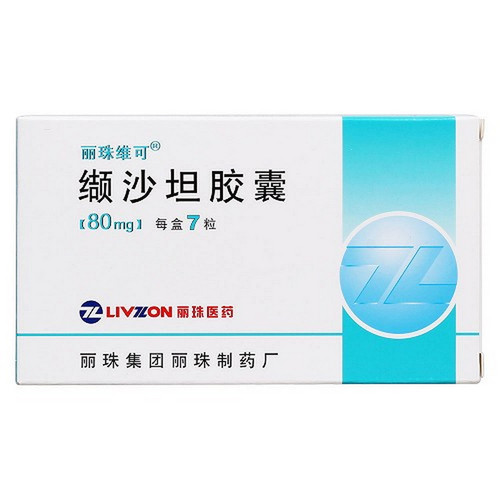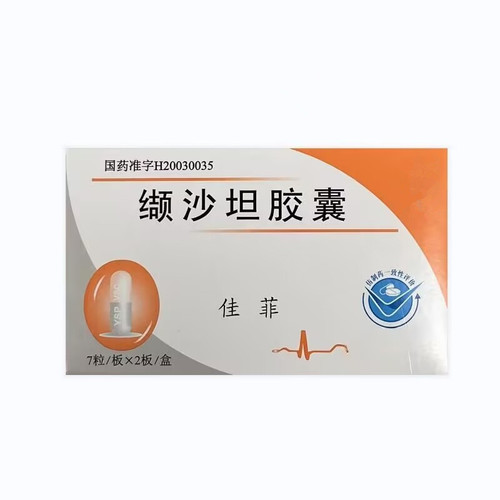Product Overview
[Drug Name]
Generic Name: Valsartan Capsules
Trade Name: Xingfukang
English Name: Valsartan Capsules
Chinese Pinyin: XieShaTanJiaoNang (XingFuKang)
[Ingredients]
Active ingredient: valsartan.
[Properties]
This product is a hard capsule containing a white powder.
[Indications]
Indicated for mild to moderate essential hypertension.
[Dosage and Administration]
Recommended dose: 80 mg once daily. Dosage is not affected by race, age, or gender. It can be taken with or without food (see Absorption). It is recommended to take the drug at the same time each day (e.g., morning). A definitive antihypertensive effect is achieved within two weeks, and maximum efficacy is achieved after four weeks. If the antihypertensive effect is unsatisfactory, the daily dose can be increased to 160 mg, or a diuretic can be added. No dose adjustment is required for patients with renal impairment (see Precautions for severe renal failure) or non-biliary, non-choledostatic hepatic insufficiency. Valsartan can be used in combination with other antihypertensive drugs.
[Adverse Reactions]
In a placebo- and Diovan-controlled trial in 2,316 hypertensive patients, the overall adverse event (AE) rate in the Diovan group was similar to that in the placebo group. In a 6-month, open-label extension trial of 320 mg of valsartan in 642 hypertensive patients, the overall AE rate was similar to that observed in the placebo-controlled trial. The table below shows the adverse event rates reported in 10 placebo-controlled trials in which patients received 10 to 320 mg of valsartan daily for up to 12 weeks. Of the 2,316 patients, 1,281 received 80 mg and 660 received 160 mg, respectively. The adverse event rate was not associated with dose or duration of treatment; therefore, adverse events occurring across all doses were combined. The adverse event rate was not associated with gender, age, or race. Incidence is defined as follows: Very rare (≥1/10); Common (≥1/100, 1/10); Uncommon (≥1/1000, 1/100); Rare (≥1/10,000, 1/1000); Very rare (1/10,000). Elevated liver function tests may occur occasionally. No specific laboratory monitoring is required for patients with essential hypertension receiving valsartan.
[Contraindications]
1. Hypersensitivity to valsartan or any other excipients in this product. 2. Pregnancy (see Pregnant and Lactating Women).
[Precautions]
1. Hyponatremia and/or hypovolemia. In rare cases, patients with severe sodium and/or hypovolemia (e.g., those taking high-dose diuretics) may experience symptomatic hypotension when starting treatment with this product. Hyponatremia and/or hypovolemia should be corrected before starting treatment, for example, by reducing the diuretic dose. If hypotension occurs, the patient should be placed in a supine position and, if necessary, receive intravenous saline. Treatment with this drug can be continued after blood pressure stabilizes. 2. Renal Artery Stenosis: Short-term use of this drug in 12 patients with secondary renovascular hypertension due to unilateral renal artery stenosis did not cause significant changes in renal hemodynamics, creatinine, or blood urea nitrogen (BUN). Because other drugs that act on the renin-angiotensin-aldosterone system (RAAS) may increase BUN and creatinine in patients with unilateral or bilateral renal artery stenosis, monitoring BUN and creatinine is recommended as a safety measure. 3. Renal Insufficiency: Dosage adjustment is necessary for patients with renal insufficiency, but there are no data on severe cases (creatinine clearance). Please read the package insert carefully and follow your doctor's instructions.
[Use in Special Populations]
Precautions for Use in Children:
The efficacy and safety of this drug in children and adolescents (under 18 years of age) have not been studied.
Precautions for Pregnancy and Lactation:
1. Pregnancy: Given the mechanism of action of angiotensin II antagonists, fetal harm cannot be ruled out. There have been reports of intrauterine administration of angiotensin-converting enzyme inhibitors (a specific class of drugs that act on the RAAS) during the second and third trimesters of pregnancy. ) can cause damage to the developing fetus or lead to fetal death. In addition, retrospective data show a potential risk of birth defects when using angiotensin-converting enzyme inhibitors during the first three months of pregnancy. There have been reports of spontaneous abortion, oligohydramnios, and neonatal renal insufficiency when pregnant women inadvertently take valsartan. Similar to other drugs that act directly on the RAAS, this product should not be used by pregnant women (see contraindications). For women of childbearing potential, doctors should inform them of the potential risks of this type of drug during pregnancy when prescribing drugs that act on the RAAS. If pregnancy is discovered during medication, valsartan should be discontinued as soon as possible. Breastfeeding: It is unknown whether valsartan is excreted in human milk. Valsartan is excreted in the milk of lactating rats. Therefore, this product should not be used during lactation.
Precautions for Elderly Patients:
Although systemic exposure to valsartan is slightly higher in the elderly than in younger adults, this is not clinically significant.
[Drug Interactions]
No significant drug interactions have been observed clinically. The following drugs have been studied: cimetidine, warfarin, furosemide, digoxin, atenolol, indomethacin, hydrochlorothiazide, amlodipine, and glyburide. Because valsartan undergoes minimal metabolism, no clinical interactions with drugs that induce or inhibit the cytochrome P450 system have been observed. Although valsartan is largely bound to plasma proteins, in vitro studies have not shown interactions with other plasma protein-bound drugs (such as diclofenac, furosemide, and warfarin) at this level. Potassium supplementation or the use of potassium-containing preparations may increase serum potassium levels when used concomitantly with potassium-sparing diuretics (such as spironolactone, triamterene, and amiloride). This medication can increase blood pressure and cause elevated serum creatinine in patients with heart failure. Therefore, caution is advised when using these drugs together.
[Pharmacological Action]
This product is an angiotensin II receptor antagonist. It selectively targets the AT1 receptor subtype known to be involved in the action of angiotensin II, selectively blocking the binding of angiotensin II to AT1 receptors on tissue cells such as the adrenal glands and vascular smooth muscle, inhibiting vasoconstriction and aldosterone secretion, resulting in a hypotensive effect. Its affinity for AT1 receptors is approximately 20,000 times higher than for AT2 receptors. This product does not affect the action of bradykinin or ion channel function, nor does it bind to the receptors of other hormones that play an important role in regulating cardiovascular function. This product is non-carcinogenic, non-teratogenic, non-mutagenic, and non-reproductive.
[Storage] Store in a sealed, light-proof container.
[Specification] 80mg x 21 tablets
[Packaging Size] Box
[Expiration Period] 36 months
[Approval Number] National Medicine Standard H20133189
[Manufacturer] Company Name: Lepu Hengjiuyuan Pharmaceutical Co., Ltd.






